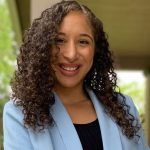Trey Sherard
Washington, DC
Trey was honored as a River Hero at River Rally 2022.
This interview was conducted by Carly Schmidt on February 9, 2022. To learn more about Trey’s work, visit https://www.anacostiariverkeeper.org/.
Transcript
You will be honored as one of the 2022 River Heroes for the full scope of your work in protecting and defending the Anacostia River. Tell me a bit about yourself and how you came into your work as a riverkeeper?
At the ripe old age of 5 or 6 I gave up my childhood dream of studying dinosaurs and decided that I wanted to be a marine biologist because I’d fallen in love with all the critters growing on docks and living in the water where I grew up on the beach in North Carolina. When I graduated with my degree in marine biology, I moved back home and started doing field work for multiple marine biology labs at UNCW and later in Puerto Rico. I helped make a lot of good science but I also realized that so much good science gets made, but doesn’t get used, and I wanted to move into that intersection. My last semester in undergrad, I took a course in US environmental policy and I started thinking that policy is where science and people meet to help make change.
All of my early work before my degree, and a fair bit of my work after my degree was in informal education like summer camps and field trips. Between the field tech work for marine biology labs and all the informal education work, I was overworked and underpaid in beautiful places from the Carolinas to the Caribbean, but I still didn’t find the right mix to make change like I desired. The education side was great and there’s certainly a ripple effect – make an impact on children and they go on to do cool and impactful things – but it turns out that I am not that patient. I wanted to see change from my own work in real time. I moved to Washington, DC when I realized that I wanted to circle back to policy work. I saw a part-time job advert for the Anacostia Riverkeeper, helping start their volunteer cleanups program and that turned into my introduction to the environmental nonprofit space 10 1/2 years ago. We built a community network around cleanups, and kept taking on new programs and grants like green infrastructure projects that happened to match more of my skill sets. When we started giving boat tours as part of our education programming I came right back into my element in outdoors informal education, and the entire time various advocacy issues from fish consumption and toxics, to swimming and sewage, kept developing my policy experience. It’s been a different job every year over the course of 10 years, but it’s been thrilling to see progress and to be part of the the community of waterkeepers, other nonprofits, agencies, and individuals who come together around the issues affecting the Anacostia River and the Chesapeake Bay.
What does your role as Anacostia Riverkeeper involve?
Day to day, this job is always different. Some days I will be in a suit in the morning for a board meeting or a Mayor’s Leadership Council meeting, and I’ll be in waders by the afternoon. It’s a lot of costume changes, a lot of audience changes, and a lot of code switching. We work in a variety of different sectors with private companies, individual donors, agencies, lawyers, scientists, kids, and all the other residents of the watershed. Perhaps these conversations are legal in nature, talking about an active case, or perhaps they’re something more technical. It has been an educational experience to come out of my science and education background to realize how complicated these relationships are. If I’m not in meetings then I am out on the river, investigating a report or tip about water quality, facilitating a cleanup, or giving a boat tour. Lifestyle-wise, this is a crazy job and very much an identity job, but it seems to suit me.
You have made a tremendous impact in various projects and roles. What accomplishment springs to mind as being the most impactful?
I started by working on trash cleanups. The fact that this program now has its own momentum is very exciting, and that has been really cool to watch. We have a series of cleanups sponsored by big partners, we receive grants to facilitate cleanups for schools and various groups. It’s cool to go through an area and know that an area is clean because of the volunteers we brought to the site.
The boat tours have been very important for our river because it has been isolated for so long. It’s not easy to get to the Anacostia River. There are highways and train tracks on both sides and there aren’t a lot of entry points for people, but now there is a nice trail system that gets people here from surrounding communities. Many community members have avoided the river because they were told for generations not to go, that it was dangerous and polluted. Changing people’s opinions of the river and watching them take in this green area in the middle of DC is incredible. We have fun on these boat tours and people learn a little bit more about their city on these trips. It’s the start of a relationship with the river, and it helps turn residents and visitors alike into stewards for the Anacostia.
The folks who attend boat tours are more likely to come out to other events and City Council meetings. There is some active pollution going on in the watershed at all times and people who relate more to the river become new sets of eyes and ears able to report pollution to us and to the agencies. It is very satisfying to help end or prevent new pollution, and to help get repercussions for polluters. A lot of the big damage here, however, was done over the past 150+ years, including twin legacies of the river not being swimmable because of sewage or fishable because of toxics in the river bottom. Getting the river back to swimmable is one thing we’re working on now that’s close, like really, really close! It’s amazing to be able to say it out loud.
How have you seen the health and/or swimmability of the Anacostia River change over the last decade?
Volunteers have been monitoring water quality and bacteria over the last three years. That data shows that some sites are safe to swim, that at those sites even half the time, water quality looks pretty good. This is due to infrastructure changes in recent years that come from lawsuits brought deacades ago, new and improved infrastructure projects like the DC Water sewage tunnels that are making a big difference. 2018 was the rainiest year on record for this region, but the first big section of the sewage tunnel opened that March and kept billions of gallons of sewage and stormwater out of the river. The next section should open early 2023 and will be another big break for water quality. We’re hoping to have some kind of splash event this year to celebrate the 50th anniversary of the Clean Water Act and a swimmable Anacostia River.
What successes have you had in your fight against individual polluters?
Many of our legal actions are done under the Clean Water Act where we send a notice of intent to sue and the polluter chooses either to settle, to go to court, or to just stop polluting. The simplest case in my experience was a polluter who decided to move their discharge into the sewer instead of a creek, thereby stopping the problem for the river. That is the best case scenario, very quick and no one goes to court. Often we end up settling out of court, concluding in a consent decree, this has been the case with various groups from PEPCO, our local power utility, to many of the agencies with whom we work both ahead of time before policies are made, and after the fact either legally or with changes to policy. We don’t want to have to go to court, but we will if the changes the river needs aren’t forthcoming voluntarily. Compared to many waterkeepers, we don’t have as much litigation, but it’s because we are lucky that we have a lot of proactive and forward thinking agencies here in DC, Montgomery County, and Prince George’s County. Other keepers have trouble starting a conversation while we just find ourselves pushing for things to happen faster and better.
You have worn many hats at Anacostia Riverkeeper and have faced several challenges in your various roles. What has kept you around for 10 years as a defender of this river, and how do you stay motivated?
Initially I figured that I would be in DC and at Anacostia Riverkeeper for a year. Then I figured it would be one more, then one more. DC is the first city that I moved to for more than just a visit, and the biggest part of why I am here is because of my job. I like my job, it keeps changing and growing, and I’ve been privileged to meet a fuller picture of DC than a lot of my friends, because my work in the watershed took me beyond just NW DC and throughout the the eastern half of DC in Wards 7 and 8, as well as into the counties next door in MD. A lot of young, mostly white people moving to the city just aren’t conscious of these communities but I got this complete portrait of DC because of the river. The river itself is this blue and greenway in the heart of DC. The Potomac is the border of the city, but the Anacostia actually runs through it, and it’s a beautiful waterway that is astonishing to see in the middle of a city where you can still be surrounded entirely by nature. The river kept me here and keeps me going, but the other big piece of it is the relationships with the people and the communities that I’ve been lucky enough to get to know.
About
Trey has served as a voice for the Anacostia River for nearly a decade. Trey is a gifted community organizer who has increased engagement and volunteer activity throughout the city through partnerships and education. Trey coordinates Anacostia Riverkeeper’s Clean Waterways cleanup series, Friday Night Fishing, management of several Bandalong litter traps, and ARK’s green infrastructure program. His gift of inspiration and education makes him a powerful advocate for a fishable and swimmable Anacostia. Trey holds a B.S. in Biology from Duke University.







